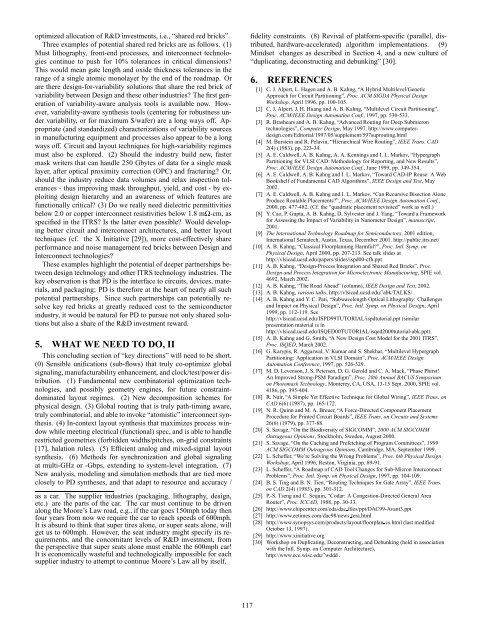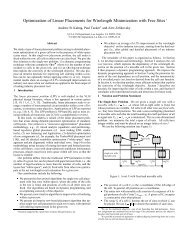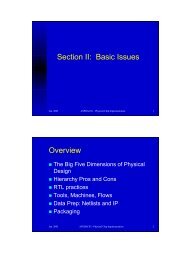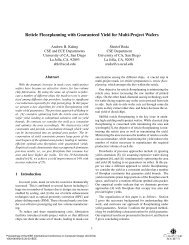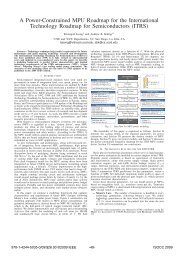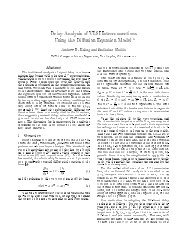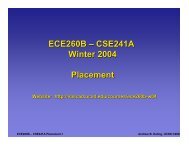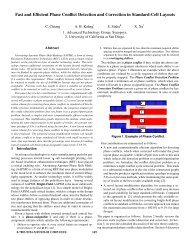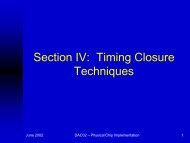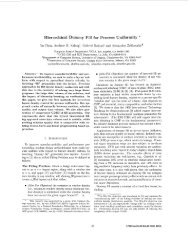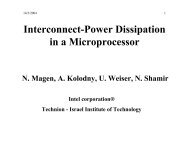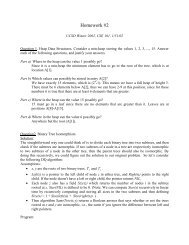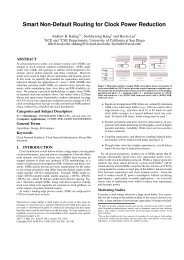A Roadmap and Vision for Physical Design - UCSD VLSI CAD ...
A Roadmap and Vision for Physical Design - UCSD VLSI CAD ...
A Roadmap and Vision for Physical Design - UCSD VLSI CAD ...
Create successful ePaper yourself
Turn your PDF publications into a flip-book with our unique Google optimized e-Paper software.
optimized allocation of R&D investments, i.e., “shared red bricks”.<br />
Three examples of potential shared red bricks are as follows. (1)<br />
Must lithography, front-end processes, <strong>and</strong> interconnect technologies<br />
continue to push <strong>for</strong> 10% tolerances in critical dimensions?<br />
This would mean gate length <strong>and</strong> oxide thickness tolerances in the<br />
range of a single atomic monolayer by the end of the roadmap. Or<br />
are there design-<strong>for</strong>-variability solutions that share the red brick of<br />
variability between <strong>Design</strong> <strong>and</strong> these other industries? The first generation<br />
of variability-aware analysis tools is available now. However,<br />
variability-aware synthesis tools (centering <strong>for</strong> robustness under<br />
variability, or <strong>for</strong> maximum $/wafer) are a long ways off. Appropriate<br />
(<strong>and</strong> st<strong>and</strong>ardized) characterizations of variability sources<br />
in manufacturing equipment <strong>and</strong> processes also appear to be a long<br />
ways off. Circuit <strong>and</strong> layout techniques <strong>for</strong> high-variability regimes<br />
must also be explored. (2) Should the industry build new, faster<br />
mask writers that can h<strong>and</strong>le 250 Gbytes of data <strong>for</strong> a single mask<br />
layer, after optical proximity correction (OPC) <strong>and</strong> fracturing? Or,<br />
should the industry reduce data volumes <strong>and</strong> relax inspection tolerances<br />
- thus improving mask throughput, yield, <strong>and</strong> cost - by exploiting<br />
design hierarchy <strong>and</strong> an awareness of which features are<br />
functionally critical? (3) Do we really need dielectric permittivities<br />
below 2.0 or copper interconnect resistivities below 1.8 mΩ-cm, as<br />
specified in the ITRS? Is the latter even possible? Would developing<br />
better circuit <strong>and</strong> interconnect architectures, <strong>and</strong> better layout<br />
techniques (cf. the X Initiative [29]), more cost-effectively share<br />
per<strong>for</strong>mance <strong>and</strong> noise management red bricks between <strong>Design</strong> <strong>and</strong><br />
Interconnect technologies?<br />
These examples highlight the potential of deeper partnerships between<br />
design technology <strong>and</strong> other ITRS technology industries. The<br />
key observation is that PD is the interface to circuits, devices, materials,<br />
<strong>and</strong> packaging; PD is there<strong>for</strong>e at the heart of nearly all such<br />
potential partnerships. Since such partnerships can potentially resolve<br />
key red bricks at greatly reduced cost to the semiconductor<br />
industry, it would be natural <strong>for</strong> PD to pursue not only shared solutions<br />
but also a share of the R&D investment reward.<br />
5. WHAT WE NEED TO DO, II<br />
This concluding section of “key directions” will need to be short.<br />
(0) Sensible unifications (sub-flows) that truly co-optimize global<br />
signaling, manufacturability enhancement, <strong>and</strong> clock/test/power distribution.<br />
(1) Fundamental new combinatorial optimization technologies,<br />
<strong>and</strong> possibly geometry engines, <strong>for</strong> future constraintdominated<br />
layout regimes. (2) New decomposition schemes <strong>for</strong><br />
physical design. (3) Global routing that is truly path-timing aware,<br />
truly combinatorial, <strong>and</strong> able to invoke “atomistic” interconnect synthesis.<br />
(4) In-context layout synthesis that maximizes process window<br />
while meeting electrical (functional) spec, <strong>and</strong> is able to h<strong>and</strong>le<br />
restricted geometries (<strong>for</strong>bidden widths/pitches, on-grid constraints<br />
[17], halation rules). (5) Efficient analog <strong>and</strong> mixed-signal layout<br />
synthesis. (6) Methods <strong>for</strong> synchronization <strong>and</strong> global signaling<br />
at multi-GHz or -Gbps, extending to system-level integration. (7)<br />
New analysis, modeling <strong>and</strong> simulation methods that are tied more<br />
closely to PD syntheses, <strong>and</strong> that adapt to resource <strong>and</strong> accuracy /<br />
as a car. The supplier industries (packaging, lithography, design,<br />
etc.) are the parts of the car. The car must continue to be driven<br />
along the Moore’s Law road, e.g., if the car goes 150mph today then<br />
four years from now we require the car to reach speeds of 600mph.<br />
It is absurd to think that super tires alone, or super seats alone, will<br />
get us to 600mph. However, the seat industry might specify its requirements,<br />
<strong>and</strong> the concomitant levels of R&D investment, from<br />
the perspective that super seats alone must enable the 600mph car!<br />
It is economically wasteful <strong>and</strong> technologically impossible <strong>for</strong> each<br />
supplier industry to attempt to continue Moore’s Law all by itself.<br />
fidelity constraints. (8) Revival of plat<strong>for</strong>m-specific (parallel, distributed,<br />
hardware-accelerated) algorithm implementations. (9)<br />
Mindset changes as described in Section 4, <strong>and</strong> a new culture of<br />
“duplicating, deconstructing <strong>and</strong> debunking” [30].<br />
6. REFERENCES<br />
[1] C. J. Alpert, L. Hagen <strong>and</strong> A. B. Kahng, “A Hybrid Multilevel/Genetic<br />
Approach <strong>for</strong> Circuit Partitioning”, Proc. ACM SIGDA <strong>Physical</strong> <strong>Design</strong><br />
Workshop, April 1996, pp. 100-105.<br />
[2] C. J. Alpert, J. H. Huang <strong>and</strong> A. B. Kahng, “Multilevel Circuit Partitioning”,<br />
Proc. ACM/IEEE <strong>Design</strong> Automation Conf., 1997, pp. 530-533.<br />
[3] R. Brashears <strong>and</strong> A. B. Kahng, “Advanced Routing <strong>for</strong> Deep Submicron<br />
technologies”, Computer <strong>Design</strong>, May 1997. http://www.computerdesign.com/Editorial/1997/05/supplement/597suprouting.html<br />
[4] M. Burstein <strong>and</strong> R. Pelavin, “Hierarchical Wire Routing”, IEEE Trans. <strong>CAD</strong><br />
2(4) (1983), pp. 223-34.<br />
[5] A. E. Caldwell, A. B. Kahng, A. A. Kennings <strong>and</strong> I. L. Markov, “Hypergraph<br />
Partitioning <strong>for</strong> <strong>VLSI</strong> <strong>CAD</strong>: Methodology <strong>for</strong> Reporting, <strong>and</strong> New Results”,<br />
Proc. ACM/IEEE <strong>Design</strong> Automation Conf., June 1999, pp. 349-354.<br />
[6] A. E. Caldwell, A. B. Kahng <strong>and</strong> I. L. Markov, “Toward <strong>CAD</strong>-IP Reuse: A Web<br />
Bookshelf of Fundamental <strong>CAD</strong> Algorithms”, IEEE <strong>Design</strong> <strong>and</strong> Test, May<br />
2002.<br />
[7] A. E. Caldwell, A. B. Kahng <strong>and</strong> I. L. Markov, “Can Recursive Bisection Alone<br />
Produce Routable Placements?”, Proc. ACM/IEEE <strong>Design</strong> Automation Conf.,<br />
2000, pp. 477-482. (Cf. the “quadratic placement revisited” work as well.)<br />
[8] Y. Cao, P. Gupta, A. B. Kahng, D. Sylvester <strong>and</strong> J. Yang, “Toward a Framework<br />
<strong>for</strong> Assessing the Impact of Variability in Nanometer <strong>Design</strong>”, manuscript,<br />
2001.<br />
[9] The International Technology <strong>Roadmap</strong> <strong>for</strong> Semiconductors, 2001 edition,<br />
International Sematech, Austin, Texas, December 2001. http://public.itrs.net/<br />
[10] A. B. Kahng, “Classical Floorplanning Harmful?”, Proc. Intl. Symp. on<br />
<strong>Physical</strong> <strong>Design</strong>, April 2000, pp. 207-213. See talk slides at<br />
http://vlsicad.ucsd.edu/papers/slides/ispd00-cfh.ppt<br />
[11] A. B. Kahng, “<strong>Design</strong>-Process Integration <strong>and</strong> Shared Red Bricks”, Proc.<br />
<strong>Design</strong> <strong>and</strong> Process Integration <strong>for</strong> Microelectronic Manufacturing, SPIE vol.<br />
4692, March 2002.<br />
[12] A. B. Kahng, “The Road Ahead” (column), IEEE <strong>Design</strong> <strong>and</strong> Test, 2002.<br />
[13] A. B. Kahng, various talks, http://vlsicad.ucsd.edu/˜abk/TALKS/ .<br />
[14] A. B. Kahng <strong>and</strong> Y. C. Pati, “Subwavelength Optical Lithography: Challenges<br />
<strong>and</strong> Impact on <strong>Physical</strong> <strong>Design</strong>”, Proc. Intl. Symp. on <strong>Physical</strong> <strong>Design</strong>, April<br />
1999, pp. 112-119. See<br />
http://vlsicad.ucsd.edu/ISPD99TUTORIAL/ispdtutorial.ppt (similar<br />
presentation material is in<br />
http://vlsicad.ucsd.edu/ISQED00TUTORIAL/isqed2000tutorial-abk.ppt).<br />
[15] A. B. Kahng <strong>and</strong> G. Smith, “A New <strong>Design</strong> Cost Model <strong>for</strong> the 2001 ITRS”,<br />
Proc. ISQED, March 2002.<br />
[16] G. Karypis, R. Aggarwal, V. Kumar <strong>and</strong> S. Shekhar, “Multilevel Hypergraph<br />
Partitioning: Application in <strong>VLSI</strong> Domain”, Proc. ACM/IEEE <strong>Design</strong><br />
Automation Conference, 1997, pp. 526-529.<br />
[17] M. D. Levenson, J. S. Petersen, D. G. Gerold <strong>and</strong> C. A. Mack, “Phase Phirst!<br />
An Improved Strong-PSM Paradigm”, Proc. 20th Annual BACUS Symposium<br />
on Photomask Technology, Monterey, CA, USA, 13-15 Sept. 2000, SPIE vol.<br />
4186, pp. 395-404.<br />
[18] R. Nair, “A Simple Yet Effective Technique <strong>for</strong> Global Wiring”, IEEE Trans. on<br />
<strong>CAD</strong> 6(6) (1987), pp. 165-172.<br />
[19] N. R. Quinn <strong>and</strong> M. A. Breuer, “A Force-Directed Component Placement<br />
Procedure <strong>for</strong> Printed Circuit Boards”, IEEE Trans. on Circuits <strong>and</strong> Systems<br />
26(6) (1979), pp. 377-88.<br />
[20] S. Savage, “On the Biodiversity of SIGCOMM”, 2000 ACM SIGCOMM<br />
Outrageous Opinions, Stockholm, Sweden, August 2000.<br />
[21] S. Savage, “On the Caching <strong>and</strong> Prefetching of Program Committees”, 1999<br />
ACM SIGCOMM Outrageous Opinions, Cambridge, MA, September 1999.<br />
[22] L. Scheffer, “We’re Solving the Wrong Problems”, Proc. 6th <strong>Physical</strong> <strong>Design</strong><br />
Workshop, April 1996, Reston, Virginia, pp. 89-91.<br />
[23] L. Scheffer, “A <strong>Roadmap</strong> of <strong>CAD</strong> Tool Changes <strong>for</strong> Sub-Micron Interconnect<br />
Problems”, Proc. Intl. Symp. on <strong>Physical</strong> <strong>Design</strong>, 1997, pp. 104-109.<br />
[24] B. S. Ting <strong>and</strong> B. N. Tien, “Routing Techniques <strong>for</strong> Gate Array”, IEEE Trans.<br />
on <strong>CAD</strong> 2(4) (1983), pp. 301-312.<br />
[25] P.-S. Tseng <strong>and</strong> C. Sequin, “Codar: A Congestion-Directed General Area<br />
Router”, Proc. IC<strong>CAD</strong>, 1988, pp. 30-33.<br />
[26] http://www.chipcenter.com/eda/dac files/ppt/DAC99-Avant3.ppt<br />
[27] http://www.eetimes.com/dac98/news tera.html<br />
[28] http://www.synopsys.com/products/layout/floorplan cs.html (last modified<br />
October 13, 1997).<br />
[29] http://www.xinitiative.org<br />
[30] Workshop on Duplicating, Deconstructing, <strong>and</strong> Debunking (held in association<br />
with the Intl. Symp. on Computer Architecture),<br />
http://www.ece.wisc.edu/˜wddd .<br />
117


